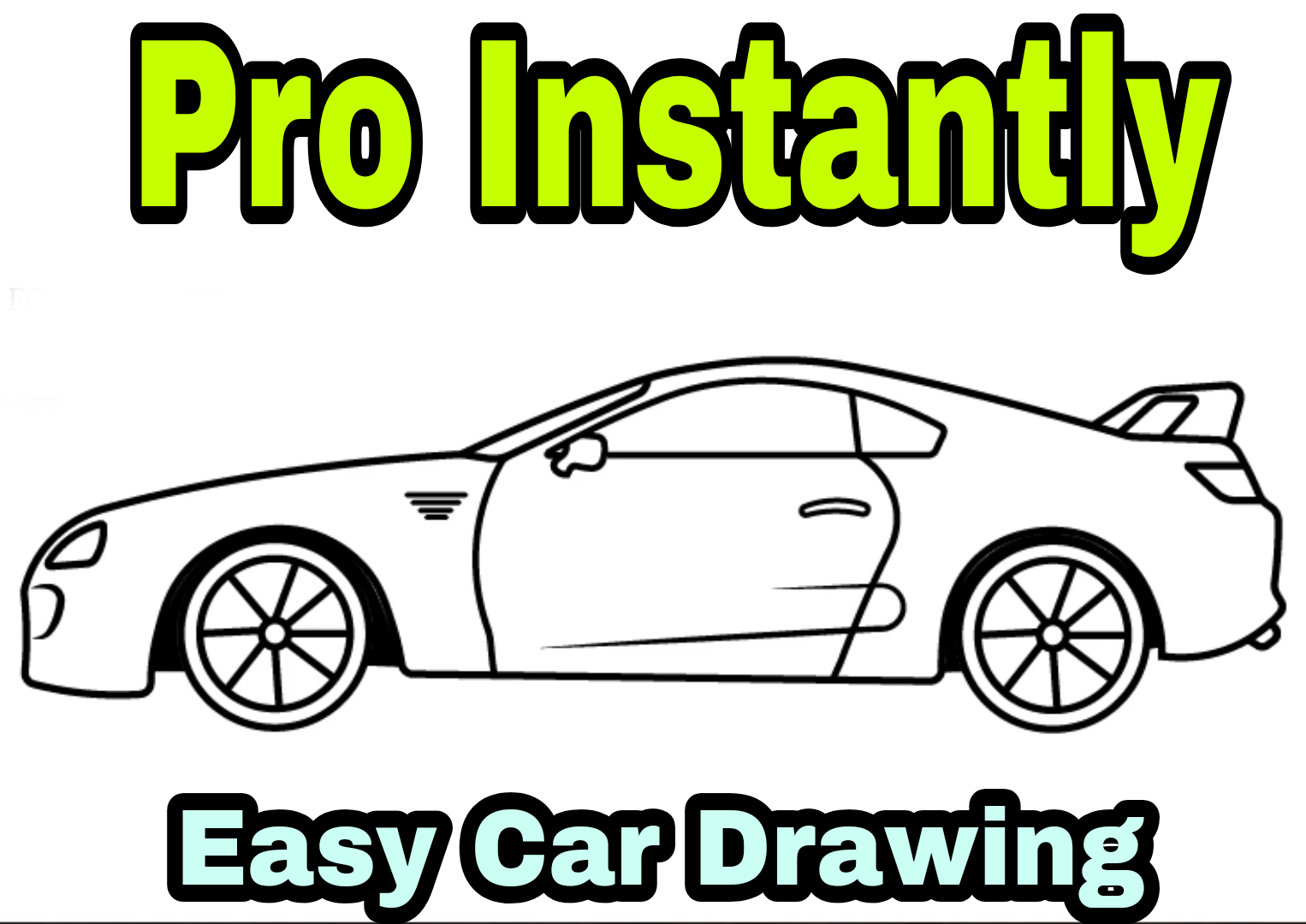Introduction:
Car Drawing can be a challenging but highly rewarding endeavor. Whether you’re an aspiring car designer or simply a car enthusiast looking to capture your favorite vehicles on paper, improving your car drawing skills can unlock a world of creativity. This ultimate guide will provide you with the knowledge and techniques needed to enhance your car drawing abilities and bring your automotive artwork to life.

Why car drawing is challenging:
Drawing cars presents unique challenges compared to other subjects. The sleek and complex shapes, precise proportions, and intricate details of automobiles require a solid understanding of car anatomy and technical skills. By mastering the fundamentals and practicing various techniques, you can overcome these challenges and create impressive car drawings.
The benefits of improving your car drawing skills:
Enhancing your car drawing skills offers several benefits beyond the joy of creating beautiful artwork. By immersing yourself in the study and creation of car drawings, you’ll cultivate a profound admiration for the art of car design, unraveling the intricacies and aesthetic allure of automotive craftsmanship.
- Improve observation and attention to detail: Drawing cars requires keen observation and attention to the minute details of their forms, helping you develop a sharp eye for detail.
- Boost creativity and self-expression: Car drawing serves as a creative outlet, allowing you to express your unique perspective and ideas through your artwork.
- Enhance spatial awareness and visual thinking: As you master perspective, proportions, and lighting, you’ll develop better spatial awareness and improve your ability to visualize objects in three dimensions.
Now, let’s embark on a captivating exploration of the indispensable tools and techniques that will propel your car drawing abilities to new heights.

Essential Tools for Car Drawing:
To create impressive car drawings, you’ll need the following essential tools:
- Pencils: What kind to use
- Choose high-quality graphite pencils with varying levels of hardness (ranging from 2H to 6B) to achieve different line weights and shading effects. Experiment with different pencils to find the ones that suit your preferences.
- Erasers: Which types work best
- Invest in soft erasers, such as kneaded erasers or vinyl erasers, as they allow you to erase selectively without damaging the paper. These erasers are ideal for correcting mistakes and refining details.
- Paper: Which paper has the right texture
- Use smooth, heavyweight drawing paper or bristol board to provide a sturdy surface for your drawings. Opt for acid-free paper to ensure the longevity of your artwork.
- Other Materials: Needed for shading, highlighting, and detailing
- Additional materials such as blending stumps, tortillions, chamois, and cotton swabs are useful for blending and smudging graphite to create smooth shading. White gel pens or colored pencils can be used for highlighting and adding fine details.
- Understanding Car Anatomy: The Fundamentals
- Before diving into the techniques of car drawing, it’s crucial to understand the fundamentals of car anatomy. This knowledge will help you accurately depict the structure and proportions of vehicles in your drawings.
- Basic Shapes: Understanding the foundation of car forms
- Cars can be broken down into different geometric shapes like cubes, cylinders, and spheres. Learning to identify and draw these shapes will provide a solid foundation for accurately constructing cars in different perspectives.
- Perspective: Mastering proper proportions and foreshortening
- Perspective is crucial in car drawing to create a sense of depth and realism. Understand the principles of one-point, two-point, and three-point perspective, as well as foreshortening, to accurately depict cars from various angles.
- Lighting: Learning how light affects form and shadows Lighting plays a significant role in car drawing. Understanding how light interacts with different surfaces, creating highlights, shadows, and reflections, will bring depth and dimension to your car drawings.

15 New Sketching and Lining Techniques For Drawing Car:
Once you grasp the fundamentals of car anatomy, it’s time to start sketching and refining your drawings. These techniques will help you create accurate outlines and capture the essence of the car’s design.
- Sketching Rough Outlines: Brainstorming ideas for the drawing
- Begin with loose, light sketches to explore different perspectives and compositions. Sketching rough outlines allows you to experiment and refine your ideas before committing to the final drawing.
- Lining Techniques: Creating smooth and precise outlines
- Use confident and deliberate linework to create smooth and precise outlines. Start with light lines, gradually increasing the pressure to darken and refine them. Use guidelines and construction lines to maintain proper proportions.
- Overcoming Mistakes: Correcting mistakes without ruining the drawing
- In the drawing, mistakes can happen anytime. Learn how to erase and correct errors without damaging the paper or smudging the graphite. Patience and attention to detail will help you overcome mistakes gracefully.
- Adding Detail: The Devil is in the Details
- The small details of a car drawing can make a significant difference in its realism. Pay attention to specific features like wheels, grilles, headlights, and other distinctive elements that define the car’s character.
- Creating the Wheels and Tires: Perfecting the circle and tire tread
- Drawing wheels and tires accurately can be challenging. Mastering the technique of drawing perfect circles and capturing the intricate patterns of tire treads will elevate the realism of your car drawings.
- The Importance of Grilles and Headlights: Adding personality to your car
- Grilles and headlights are often the face of a car, giving it character and personality. Pay attention to the unique design elements of these components and ensure they accurately represent the car you’re drawing.
- Door Handles, Mirrors, and Other Detailing Techniques: Adding realism and depth
- Small details like door handles, side mirrors, and other components contribute to the overall realism and depth of your car drawings. Incorporate these elements thoughtfully to enhance the authenticity of your artwork.
- Shading Techniques: Creating the Illusion of Depth
- Shading is a fundamental technique in car drawing that adds depth and volume to your artwork. Understanding light and shadow and applying shading techniques will bring your car drawings to life.
- Understanding Shading and Shadows: Qualities of light and shadow
- Observe how light interacts with objects in real life and study the different qualities of shadows. Learn to identify highlights, mid-tones, and cast shadows to create realistic shading in your car drawings.
- Choosing a Light Source: Establishing a consistent source of light
- Decide on a consistent light source for your drawing and ensure that the shadows and highlights are consistent throughout. This will make your drawing appear more cohesive and realistic.
- Rendering Techniques: Creating different textures with shading
- Experiment with various shading techniques to create different textures in your car drawings. Whether it’s rendering smooth metal surfaces or capturing the texture of fabric or leather, shading techniques can add depth and realism.
- Coloring Techniques: Adding the Final Touches
- Adding color to your car drawings can bring them to life and enhance their visual impact. Consider the following techniques when choosing colors for your artwork.
- Materials Used for Coloring: Pencils, pastels, or markers?
- Select the coloring materials that best suit your style and preferences. Colored pencils offer control and precision, while pastels or markers can provide bold and vibrant colors. Experiment with different mediums to find your preferred coloring method.
- Choosing the Right Color: How to pick a winning color palette
- When coloring cars, consider the car’s make, model, and era. Research color schemes used on similar cars or explore your creativity by inventing unique color combinations. Pay attention to complementary colors and contrast to make your drawings visually appealing.
- Creating a Gradient: Gradually blending colors to create a smooth effect
- Gradients can add depth and dimension to your car drawings. Practice blending colors smoothly to create a seamless transition from light to dark or to capture the reflections and highlights on car surfaces.

Gift:
Claim our premium worksheet practice book For Free (Only for you) :
Tips and Tricks for Improving Your Car Drawing Skills:
Mastering car drawing skills takes time and practice. Here are a few tips and tricks to help you improve your abilities and increase your artistic journey.
- Practice Makes Perfect: How to get a lot of practice in
- Regular practice is essential for improving any skill, including car drawing. Dedicate time to draw cars consistently, and challenge yourself by tackling different perspectives, styles, and car models. The more and more you practice, the faster you’ll progress.
- Study Other Artists: How to study other car artists and learn from them
- Studying the work of other car artists can provide valuable insights and inspiration. Analyze their techniques, observe how they capture form and detail, and incorporate their approaches into your own artwork. Learn from their expertise and adapt their methods to suit your style.
- Finding Inspiration: Techniques for cultivating inspiration when you need it
- Inspiration can come from various sources. Visit car shows, explore car design books and magazines, and browse online galleries to immerse yourself in the world of cars. Experiment with different styles and perspectives to keep your creative spark alive.
- Staying Motivated: Tips for not getting discouraged
- Improving your car drawing skills requires perseverance. Don’t be discouraged by initial setbacks or unsatisfactory drawings. Embrace the learning process, celebrate your progress, and seek constructive feedback to continue growing as an artist.

Conclusion:
Improving your car drawing skills is an exciting and rewarding journey. By understanding car anatomy, practicing essential techniques, and experimenting with various tools and materials, you’ll elevate your artwork to new heights. Embrace the challenges, stay motivated, and enjoy the process of bringing your favorite cars to life on paper.
Remember, the more you practice and explore, the more your car drawing skills will flourish. So, grab your pencils, erasers, and paper, and embark on your adventure to become a master car artist.

Pertinent FAQs
- What is the best way to learn car drawing?
- The best way to learn car drawing by going through a combination of practice, study, and observation. Regularly draw cars from different angles, study car anatomy and design principles, and observe the work of other car artists. Take advantage of online tutorials, books, and resources that provide step-by-step guidance and insights into car drawing techniques.
- Do I need any special equipment to draw a car?
- While special equipment is not necessary, having the right tools can greatly enhance your car drawing experience. Invest in high-quality graphite pencils with different levels of hardness, soft erasers, and smooth heavyweight drawing paper or bristol board. Additional materials like blending stumps, tortillions, and cotton swabs can aid in shading and blending techniques.
- How long does it take to get good at car drawing?
- The time it takes to become proficient in drawing cars varies from person to person. The progress you make in honing your car drawing skills is intricately linked to the dedication and commitment you devote to consistent practice and continuous learning. With consistent practice and dedication, you can start seeing noticeable improvements in your car drawing skills within a few months. However, achieving mastery may take several years of continuous learning and refinement.
- Where can I find resources for car drawing inspiration?
- There are numerous resources available to find inspiration for car drawing. Visit local car shows and exhibitions to see cars up close and capture their essence. Explore books, magazines, and online platforms dedicated to car design and art. Online galleries, social media platforms, and car enthusiast forums also provide a wealth of inspiration from other car artists and designers.
- Is there a specific style I should follow when drawing cars?
- There is no specific style you should follow when drawing cars. Embracing the development of your distinct artistic style is highly encouraged, as it empowers you to unleash the full spectrum of your individuality and creative expression. However, it can be helpful to study different styles and approaches to gain inspiration and insights from various artists. Experiment with different techniques and find the style that resonates with you the most.
Bonus:
You may check out our most helpful article about how you can help your child to do extremely well in drawing https://bloggchain.com/category/puzzle/drawing/
Sponsored By:
To grow your business and take it to the next level of success, contact https://elonmusktrillion.com/ for amazing digital marketing services at an affordable price.




Pingback: The Ultimate Easy Guide to Cat Drawing: New Tips and Tricks in 2023 - Bloggchain
Pingback: New Hibiscus Flower Drawing Techniques in 2023: Showcase Your Artistic Talent - Bloggchain